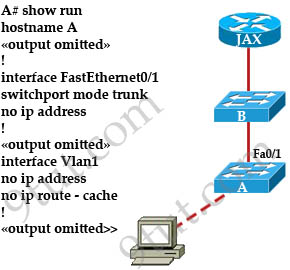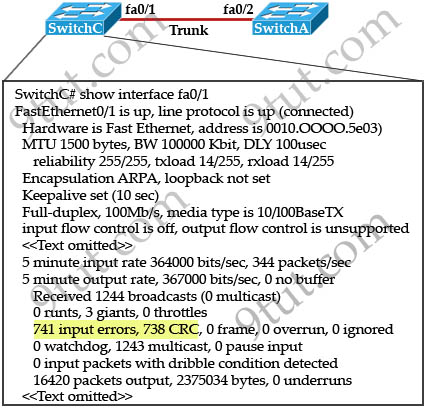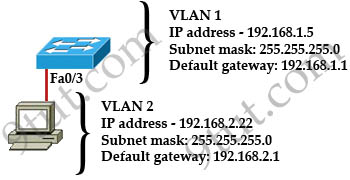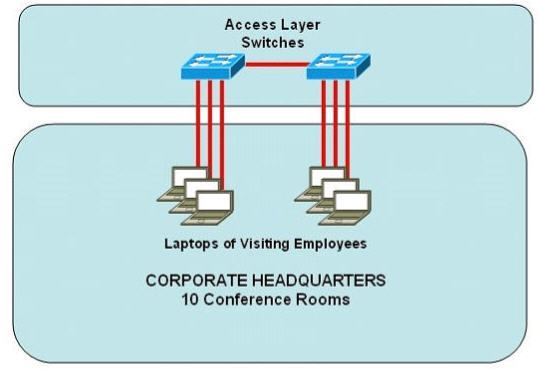CCNA – Switch Questions 2
Here you will find answers to Switch Questions – Part 2
Question 1
In which circumstance are multiple copies of the same unicast frame likely to be transmitted in a switched LAN?
A. after broken links are re-established
B. in an improperly implemented redundant topology
C. when upper-layer protocols require high reliability
D. during high traffic periods
E. when a dual ring topology is in use
Answer: B
Explanation
If we connect two switches via 2 or more links and do not enable STP on these switches then a loop (which creates multiple copies of the same unicast frame) will occur. It is an example of an improperly implemented redundant topology.
Question 2
An administrator would like to configure a switch over a virtual terminal connection from locations outside of the local LAN. Which of the following are required in order for the switch to be configured from a remote location? (Choose two)
A. The switch must be configured with an IP address, subnet mask, and default gateway.
B. The switch must be connected to a router over a VLAN trunk.
C. The switch must be reachable through a port connected to its management VLAN.
D. The switch console port must be connected to the Ethernet LAN.
E. The switch management VLAN must be created and have a membership of at least one switch port.
F. The switch must be fully configured as an SNMP agent.
Answer: A C
Explanation
In order to remote access to a switch from outside of the local LAN (in a different subnet) we have to:
+ Configure an IP address on a VLAN on that switch, this VLAN is known as the management VLAN (it is usually VLAN 1)
+ Specify the default gateway for that switch so that it can send traffic to this gateway
Below shows an example of configuring remote access for a switch (suppose the management VLAN on the switch is 192.168.1.10/24 and the default-gateway IP address is 192.168.1.254)
Switch(config)#ip default-gateway 192.168.1.254
Switch(config)#interface vlan 1
Switch(config)#ip address 192.168.1.10 255.255.255.0
Switch(config)#no shutdown
Question 3
Refer to the exhibit. A junior network administrator was given the task of configuring port security on SwitchA to allow only PC_A to access the switched network through port fa0/1. If any other device is detected, the port is to drop frames from this device. The administrator configured the interface and tested it with successful pings from PC_A to RouterA, and then observes the output from these two show commands.

Which two of these changes are necessary for SwitchA to meet the requirements? (Choose two)
A. Port security needs to be globally enabled.
B. Port security needs to be enabled on the interface.
C. Port security needs to be configured to shut down the interface in the event of a violation.
D. Port security needs to be configured to allow only one learned MAC address.
E. Port security interface counters need to be cleared before using the show command.
F. The port security configuration needs to be saved to NVRAM before it can become active.
Answer: B D
Explanation
As we see in the output, the “Port Security” is in “Disabled” state (line 2 in the output). To enable Port security feature, we must enable it on that interface first with the command:
SwitchA(config-if)#switchport port-security
-> B is correct.
Also from the output, we learn that the switch is allowing 2 devices to connect to it (switchport port-security maximum 2) but the question requires allowing only PC_A to access the network so we need to reduce the maximum number to 1 -> D is correct.
Question 4
A company implements video conferencing over IP on their Ethernet LAN. The users notice that the network slows down, and the video either stutters or foils completely. What is the most likely reason for this?
A. minimum cell rate (MCR)
B. quality of service (QoS)
C. modulation
D. packet switching exchange (PSE)
E. reliable transport protocol (RTP)
Answer: B
Explanation
If the QoS is not configured correctly on the network, video traffic can slow down all your traffic. That company implemented video traffic and the network slows down -> maybe they don’t configure QoS so video traffic (which is very high and bursty) and data traffic have the same priority and video traffic eats all the bandwidth. QoS can solve this problem by giving higher priority for data (or voice) traffic over video traffic.
Question 5
Computer 1 is consoles into switch A. Telnet connections and pings run from the command prompt on switch A fail. Which of the following could cause this problem?

A. switch A does not have a cdp entry for switch B or router JAX
B. switch A does not have an IP address
C. port 1 on switch A should be an access port rather than a trunk port
D. switch A is not directly connected to router JAX
E. switch A does not have a default gateway assigned
Answer: B
Explanation
It’s a hard question to answer although it looks simple! From the output above we are sure that switch A does not have an IP address (on both Fa0/1 and on VLAN 1) so it can not ping or telnet to any other device -> B is correct.
Another answer seems to be correct is answer E – switch A does not have a default gateway assigned. We know that Switch A can not telnet to other device outside its subnet without having a default gateway. But the question only says “Telnet connections and pings run from the command prompt on switch A fail” without telling us where Switch A is trying to telnet or ping to. If it tries to connect to the outside network then E is correct. If it only want to connect to a device inside its subnet then a default gateway is not necessary.
So the best answer for this question is B!
Question 6
Refer to the exhibit. Give this output for SwitchC, what should the network administrator’s next action be?

A. Check the trunk encapsulation mode for SwitchC’s fa0/1 port.
B. Check the duplex mode for SwitchC’s fa0/1 port.
C. Check the duplex mode for SwitchA’s fa0/2 port.
D. Check the trunk encapsulation mode for SwitchA’s fa0/2 port.
Answer: C
Question 7
Refer to the graphic

A host is connected to switch port Fa0/3 with a crossover cable. However, the port indicator on switch port Fa0/3 is not on, and the host can not communicate with hosts that belong to VLAN2 on the same switch. Based on the information given, where is the problem?
A. The switch has been assigned an incorrect subnet mask T1
B. Switch port Fa0/3 is not configured as a trunk port
C. Switch port Fa0/3 has been blocked by STP
D. The switch and the hosts must be in the same subnet
E. The cable type is wrong
Answer: E
Explanation
To specify when we use crossover cable or straight-through cable, we should remember:
Group 1: Router, Host, Server
Group 2: Hub, Switch
One device in group 1 + One device in group 2: use straight-through cable
Two devices in the same group: use crossover cable
In this case we connect a switch and a host so we need a straight-through cable -> E is correct.
Question 8
Refer to the exhibit. Some 2950 series switches are connected to the conference area of the corporate headquarters network. The switches provide two to three jacks per conference room to host laptop connections for employees who visit the headquarters office. When large groups of employees come from other locations, the network administrator often finds that hubs have been connected to wall jacks in the conference area although the ports on the access layer switches were not intended to support multiple workstations.
What action could the network administrator take to prevent access by multiple laptops through a single switch port and still leave the switch functional for its intended use?

A. Configure static entries in the switch MAC address table to include the range of addresses used by visiting employees.
B. Configure an ACL to allow only a single MAC address to connect to the switch at one time.
C. Use the mac-address-table 1 global configuration command to limit each port to one source MAC address.
D. Implement Port Security on all interfaces and use the port-security maximum 1 command to limit port access to a single MAC address
E. Implement Port Security on all interfaces and use the port-security mac-address sticky command to limit access to a single MAC address
F. Implement Port Security at global configuration mode and use the port-security maximum 1 command to allow each switch only one attached hub
Answer: D
Explanation
The Port Security filters frames based on its MAC so it can effectively prevent people connecting to the switch via hubs.
Question 9
Which of the following statements are true regarding bridges and switches? (Choose 3)
A. Switches are primarily software based while bridges are hardware based.
B. Both bridges and switches forward Layer 2 broadcasts.
C. Bridges are frequently faster than switches.
D. Switches have a higher number of ports than most bridges.
E. Bridges define broadcast domains while switches define collision domains.
F. Both bridges and switches make forwarding decisions based on Layer 2 addresses.
Answer: B D F
Question 10
A network administrator must configure 200 switch ports to accept traffic from only the currently attached host devices. What would be the most efficient way to configure MAC-level security on all these ports?
A. Visually verify the MAC addresses and then telnet to the switches to enter the switchport-port security mac-address command.
B. Have end users e-mail their MAC addresses. Telnet to the switch to enter the switchport-port security mac-address command.
C. Use the switchport port-security MAC address sticky command on all the switch ports that have end devices connected to them.
D. Use show mac-address-table to determine the addresses that are associated with each port and then enter the commands on each switch for MAC address port-security.
Answer: C
Explanation
We can use the “interface range” command (for example “interface range FastEthernet 0/1 – 48″) to configure many ports as the same time and use the “port-security MAC address sticky” command (without a specific MAC address) to dynamically learn the attached MAC Address and place it into the switch’s running-configuration -> C is correct.



@9tut
Question 1
In which circumstance are multiple copies of the same unicast frame likely to be transmitted in a switched LAN?
A. after broken links are re-established
B. in an improperly implemented redundant topology
C. when upper-layer protocols require high reliability
D. during high traffic periods
E. when a dual ring topology is in use
I think the correct answer is ( B )
am i right?????????
@abdelrady
i’d go for B too
@abdelrady @xallax: Yes, thanks for your detection. I updated it!
Experts,
Regarding Q5 :
The question says : Telnet connections and pings run ‘from’ the command prompt on switch A fail
Do you think, if it would have been ‘Telnet connections and pings run TO the command prompt on switch A fail’ then the answer should have been because NO IP ADDRESS has been configured.
In this case, dont you think, the default gateway seems more appropriate?
Please suggest!
@Vinie: In both cases we need an IP address on switchA. The default gateway is needed when telnet or pings to switch A from outside hosts (or hosts on different network).
Regarding Q5
Does the cable being a crossover cable have any effect on the ping not working?
@mallery: It depends on supporting of MDI/MDIX on interface, but it will affect not only the ping – it will affect layer 1.
Hi guys,
Regarding Q8:
I think E is the right answer.
Please explain y D is the right answer.
Thanks
@CCNA
Port security is only used on access port (which connects to hosts) so we need to set that port to “access” mode, then we need to specify the maximum number of hosts which are allowed to connect to this port -> C is correct.
Note: If we want to allow a fixed MAC address to connect, use the “switchport port-security mac-address ” command.
Question 5 –> Answer “E” is correct, we can run a switch without IP but not with out GW.
Read this statement again and again based on sh run provided.
Telnet connections and pings run from the command prompt on Switch A fails, —>
Oops confused as there is no full config on the exhibit, he only gave sh run for port & VLAN1 not gateway end…so “B” correct?
can anyone help me send the latest dump plssss..
i still have 3 days left. here’s my email: l1ttl3j0@yahoo.com
Can someone explain the answer in Q6?? I don’t get it.. thanks in advance..
@franco
take a look at the number of giants, that means that the link is getting frames bigger than the specified MTU.
also, there is is a high number of input errors out of which 738 are CRC errors. these are a result of unmatched duplex mode mostly.
we have to suspect the duplex mode as we see that there were hundreds of packets that came in and thousands of packets that left the switch on this interface (fa0/1)
duplex mismatch is recognized by poor network efficiency caused by dropped frames
Can anybody explain me Q-6 answer?
@asad
please read my post just above yours, thank you
I do not agree with answer to Question 1. A loop will result in the same packet going around and around. Not a duplicate packet. The best answer is during high traffic (D). A timeout wil result in a retransmission (assuming TCP).
@steve
In which circumstance are multiple copies of the same unicast frame likely to be transmitted in a switched LAN?
A. after broken links are re-established
the STP process runs again and the root bridge election process is ran again (if needed) and makes it all work smoothly
B. in an improperly implemented redundant topology
this is more likely what happens when you’re not running STP: frames will start flooding the network and you will end up having multiple copies of the same frame reaching the same destination after some time.
C. when upper-layer protocols require high reliability
they use TCP
D. during high traffic periods
the overall speed will decrease for all users as the connection between the gateway and the switch that gets connected to it gets overused. that’s normal
this doesn’t mean your network is improperly configured nor does it mean you will have multiple copies of the same frame on the network.
this just means your network’s bandwidth is used close to its maximum (as it should be).
E. when a dual ring topology is in use
STP makes sure it’s all running good by electing a root bridge
@ 9tut
@ xallax plz explain this question..
which two privledge mode cisco ios commands can be used to determine a cisco router chasis serial number? (choose two
A. show inventory
b. show file:filesys
c.dir flash :include chasis
d.show diag
e,show controllers
answer a,d (dumps
another question. plz a little confude.
http://uploadpic.org/v.php?img=6m83C3jJQq
http://uploadpic.org/v.php?img=4ZT92dfL0K
@z
yeap, A and D are correct
@z
regarding the second question:
it will use the IP of the remote host (the destination)
and
the MAC address of the next hop device (the default gateway – the router interface connected to the LAN on which the sender is)
regarding Q2 can someone plz explain what “the switch must be reachable through a port connected to its management vlan” means? thanks
@ xallax
tnx…the second question pretty match clear…but the first still hv doubt.
“show inventory”, “show diag” cmd i couldnt find them on pckt tracer.
@z
they arent available on packettracer, but they work just fine on GNS
again regarding Q2
if you are configuring sw over vty why does it have to be reachable through a port connected to its management vlan?
hope someone can explain it to me
thanks in advance :)
@ xallax
ya you are right. this question appear on my exam today N i choose A& D.its correct (i got 1000)
tnx man for all ur help.
going for CCNP bt nt decide yet whether ROUTE or SWITCH first…any advice ?
@z
congratz!
well, no matter what you chose you will still have to face the other 2.
good luck!
@ Z, Congrats! for your exam ..
@ Xallax.. regarding Host A to Host B ping testing and ARP result.. I could not agree with answer ip would be remote host B and mac-address of default gateway.. seems that is true for network devices, but is that same for hosts?
I have tested right from my laptop, verified “arp -a” entries.. Ping to gmail.com ping successful.. but could not found gmail’s ip address in the arp entry of my laptop.. so am I missing something or hosts used to record arp entries of gateway only for out of gateway entries? Then answer would be “D”
Thanks in advance..
@g
arp -a should display the MACs and IPs of devices on the LAN
command used show ip arp
@9tut
@xallax
Q1= by defaut stp enable so switching loop not create
iam confuse
hi
about Q8, I think both D & E are correct
because the command: …port-security maximum… is the optional and default is 1 mac-add
and I think if have only the command: “switchport port-security” also met the requirement of Q8, of course have been configured “switchport mode access” .
please give me some advices, I sorry because my Eng.
@xallax
@z
I believe that arp table of Host A will be filled in with ip of default gw (R1) and its MAC.
The ip of host B won’t be present.
@kindrock
E is not correct because if you configure mac-address sticky the first MAC address will be remembered and only that MAC add will be able to forward traffic on that port. When new user comes and plugs into sw violation will be registered and port will be disabled. The point of the question is to prevent use of hubs and not to limit the use of the sw for particular users.
You are right about command “switchport port-security”
@maja
thanks so much !
In Q2, Option C (one of the correct answers), “The switch must be reachable through a port connected to its management VLAN.” I think the port referred to here is the management interface like in the configuration:
Switch(config)#interface vlan 1
correct me if I’m wrong here.
Q2
Workstation connected to port assigned to the management VLAN can establish IP connections to the switch, that’s ok
I got confused because the question is about configuring switch from the host outside the local LAN but I guess point is that you first have to be able to connect from the local LAN
Hi, one quick ques. For ques1, the ans is E as per 486Q and here it is mentioned as B. Pls confirm the rite one? thnx in advance !!
Question 6…. Can anyone explain how the answer is – “Check the duplex mode for SwitchA’s fa0/2 port.”
Or point me to the tutorial where they explain this. Thanks in advance
@Decannon04: A reason for the “input errors” increases is the mismatched duplex mode. For example if port fa0/2 of SwitchA is set to half-duplex then the “input errors” will increase when two switches send traffic at the same time.
i am with Decannon that question was clear to me either after examinig the out put. I woul dhave never com up with the answer being duplex setting even though yes in reality and production network it would be a factor. Just being presented with the 1 switch info i would not have gotten it
thats is was not clear to me sorry for the error
Thanks 9tut
pls regarding Q1
can option E also be considered if asked to choose 2 options.tnx
Hi, For ques1, the ans is E as per 802 and here it is mentioned as B. Pls confirm the rite one? becZ i’m confused. thnx in advance !!
what are the advantages and dis advantages b/w ckt switchng and packet switching?
Hi 9tut… Hi Guys! Can you please help me… I will take exam this Feb. Please send me latest dump so that I will have an idea for the exam.. rico.blake@ymail.com
Thanks Guys!
very useful questions thanks 9tut :)
@9tut
do the address learnt dynamically through sticky command age out?
Thank you